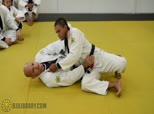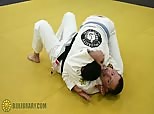Inside the University 499 - Pushing Off the Shoulder
Add to Favorites Remove From Favorites 764 2412 days ago
Fine tuning some details, Xande explains how he places his top hand at his opponent's clavicle, with the edge of the pinky finger side making the initial contact. His other hand can stay down at the hip to keep a block and feel his opponent's movement. After Xande makes his first hip bump, now he can extend his upper body to straighten his arm, rather than just trying to push the shoulder away. This gives him the space he needs to bring his leg back in and recover his guard.
Inside the University 498 - Replacing Guard from Side Control
Add to Favorites 771 Remove From Favorites 2413 days ago
With his opponent on his side control, Xande places both hands on his opponent's shoulder, his outside foot flat on the mat and his inside foot on its side with his knee attached to the body. He steps his flat foot out a bit and makes his first small hip escape. Now he has a little space to take another step and push off the shoulder for a big hip escape, and he can bring his leg in to begin replacing guard.Inside the University 470 - Pushing Yourself Out of a Hole
Add to Favorites 816 Remove From Favorites 2465 days ago
Using the idea of pushing himself up out of a hole, Xande explains the importance of pushing at the correct angle when escaping side control or recovering guard. When he pushes off his opponent, his arms directed down from his body, not away in front. This gives him the leverage and space he needs to escape and recover.Inside the University 469 - Anticipating Side Control
Add to Favorites 925 Remove From Favorites 2466 days ago
Xande emphasizes a very important point that he is not so much playing guard at this point as he is anticipating and defending side control. With that in mind, his continuous focus is on keeping his foot out wide to keep stepping and escaping his hips so he has the space to bring his elbow frame inside. It's also very important that he does not get stuck flat on his back, and he is always working from his side.Inside the University 468 - Replacing Guard when Opponent Reaches His Arm Across
Add to Favorites 947 Remove From Favorites 2467 days ago
Xande's opponent does the old school pass, and this time he gets to the side and puts his arm across Xande's body to trap him with his forearm. Xande's reaction is to flare his outside leg out as wide as he can, and do an explosive bridge and hip escape to create as much space as possible. Now he can bring his forearm in to block his opponent's hips and recover his guard. Ideally Xande will react immediately and not give his opponent time to settle in.Inside the University 434 - Extending Your Body Away from Your Opponent
Add to Favorites 779 Remove From Favorites 2508 days ago
Correcting the most common mistake of his students, Saulo shows how he extends his body away from his opponent after he has connected his elbow and knee. Once his body is straight, then he can escape the hips and bring his inside leg back in to recover his guard. As always, he emphasize the need to drill over and over, repetition is the only way to learn.Inside the University 433 - Defending from Your Side
Add to Favorites 810 Remove From Favorites 2509 days ago
Answering some questions, Saulo stresses the importance of staying on your side after you bridge, and not letting your opponent flatten you out. Also, once your elbow and knee are connected, you must push off to extend your body, and then you will have the space to recover your guard.Inside the University 432 - Creating Space to Replace Guard
Add to Favorites 759 Remove From Favorites 2510 days ago
Breaking down a common mistake, Saulo stresses the importance of pushing yourself away from your opponent after bridging. Many students will bridge and immediately try to replace the guard, but they do not have the space to succeed. So it is vital to escape your hips and create the space to bring your legs in and recover guard.Inside the University 431 - Arm Positioning while Defending Side Control
Add to Favorites 778 Remove From Favorites 2512 days ago
When in bottom side control, Saulo advises against bringing your inside arm down to your opponent's hip, as this can expose your neck for attack. Second, his outside arm cups near the top of the head, where he has more control than if he cupped the neck. After he bridges, he uses his arms to push himself away from his opponent, giving him the space he needs to set up his block.Inside the University 430 - Blocking Side Control
Add to Favorites 927 Remove From Favorites 2513 days ago
After your guard has been passed and your opponent establishes side control, it's very important to stay calm and not give up the fight. Next, do not get your hands trapped against yourself or try to push his hips. Instead, Saulo traps his opponent's head by closing his biceps on it. He keeps his other arm attached to his body and his hand loose and free to move around. Now he bridges and while on his shoulder, he connects his inside elbow and knee together to protect his side. Now he is in a good position to keep blocking the side control, and has set himself up to escape when he is ready.Inside the University 415 - Escaping Side Control when Opponent Switches His Base
Add to Favorites 968 Remove From Favorites 2557 days ago
Again from side control, this time Xande's opponent switches his base right away, turning his hips toward Xande's head. Xande keeps with the idea of using his forearm to create a belt on his opponent's waist, with his hand on the hip and elbow on the mat. While pushing off with his frames, Xande can scoot his feet away to create the space he needs to turn to his hip and sneak his knee in under his opponent's hips. Now he can work to shimmy leg through to replace the guard.Inside the University 414 - Controlling Your Opponent's Hips While In Side Control
Add to Favorites 907 Remove From Favorites 2558 days ago
Xande's opponent has side control, so again Xande is making his frames with his forearms, and his bottom arm is staying across the waist like a belt. As Xande escapes his hips to try to replace guard, his opponent reacts by turning his hips toward Xande and trying to stay in a side control position. This gives Xande just enough time and space to slide his knee in and connect it to his elbow. Now both his forearm and knee are working together to block his opponent from reestablishing a strong side control, and eventually Xande can create the space to bring his leg all the way through and replace his guard.











